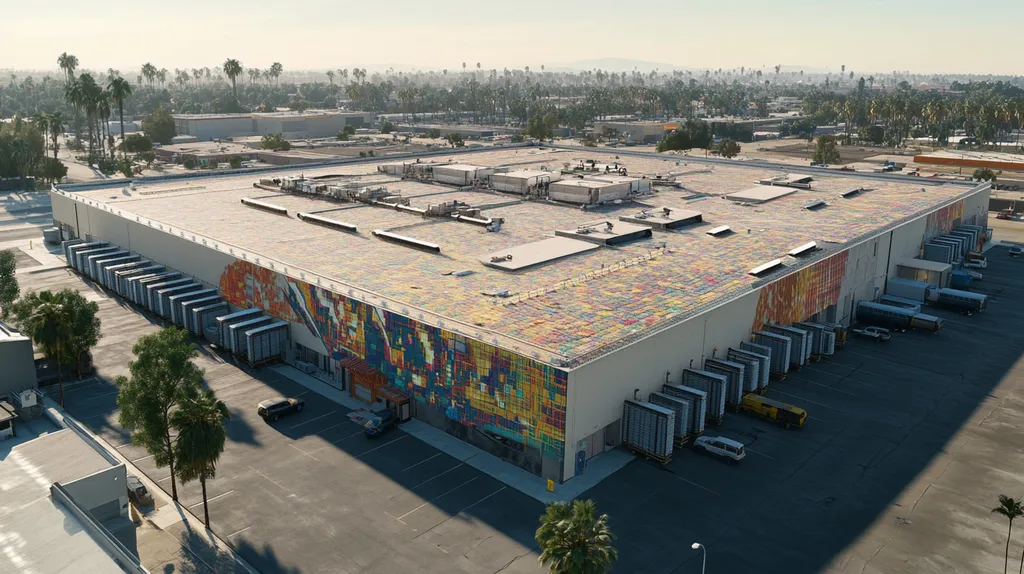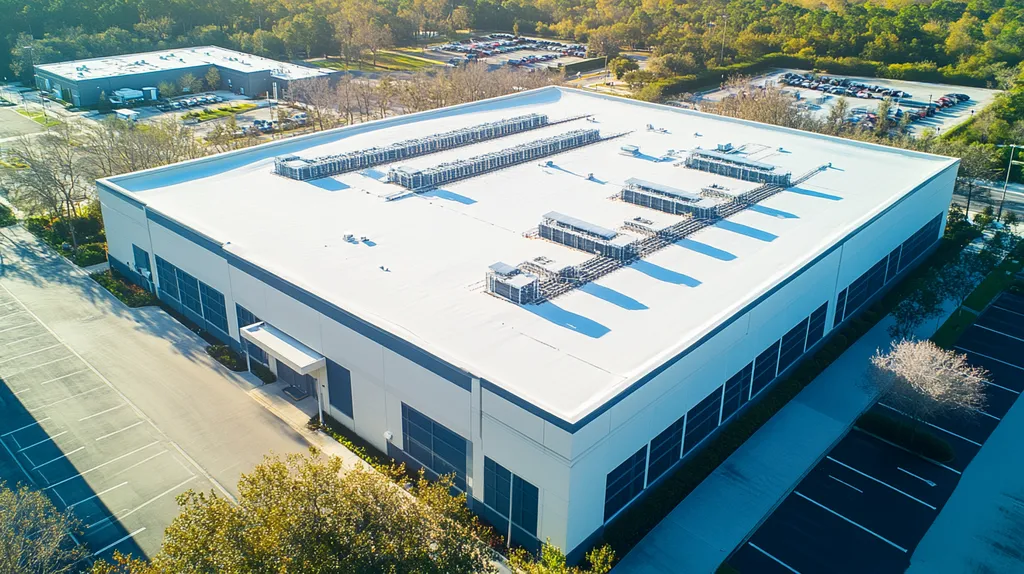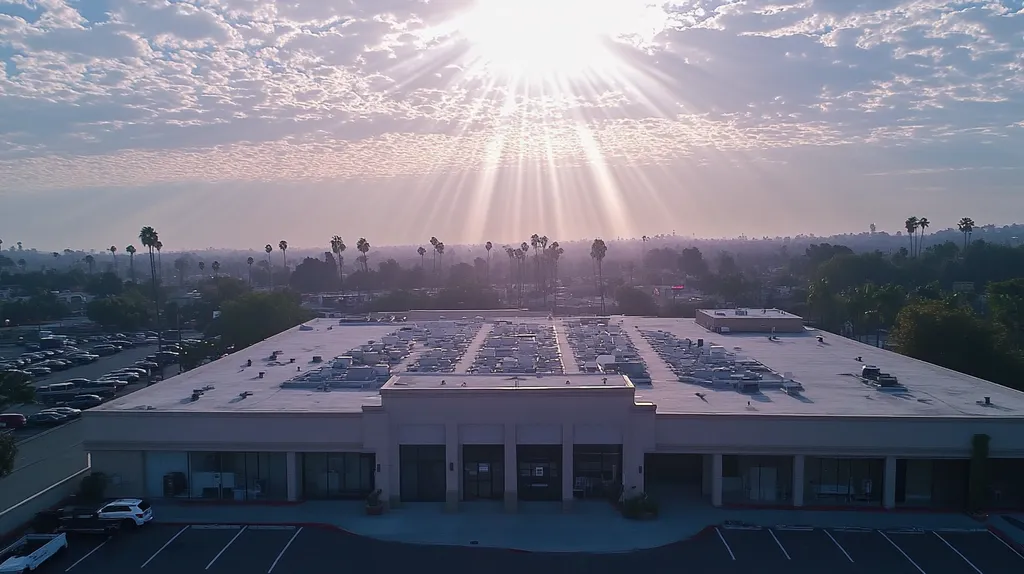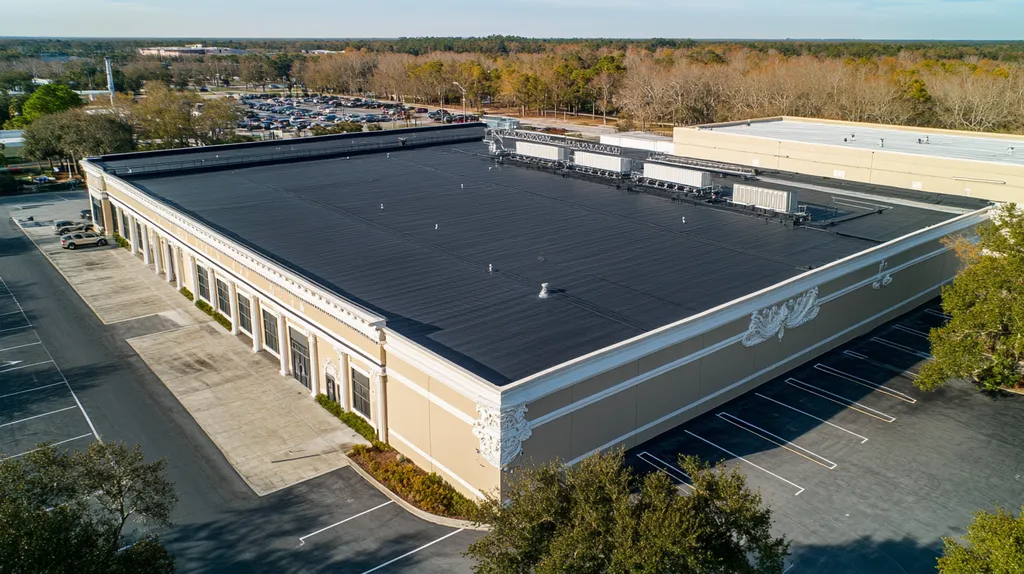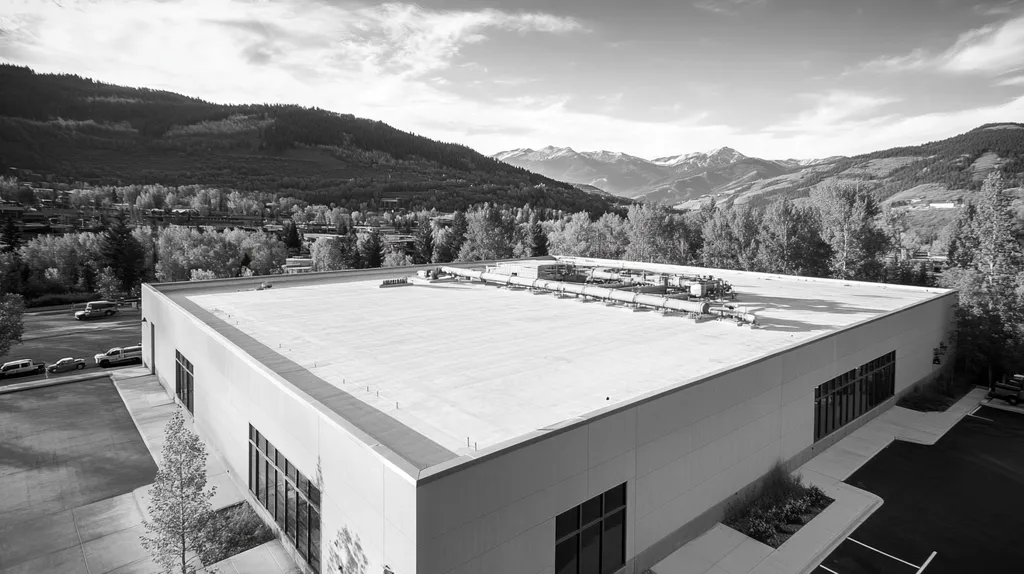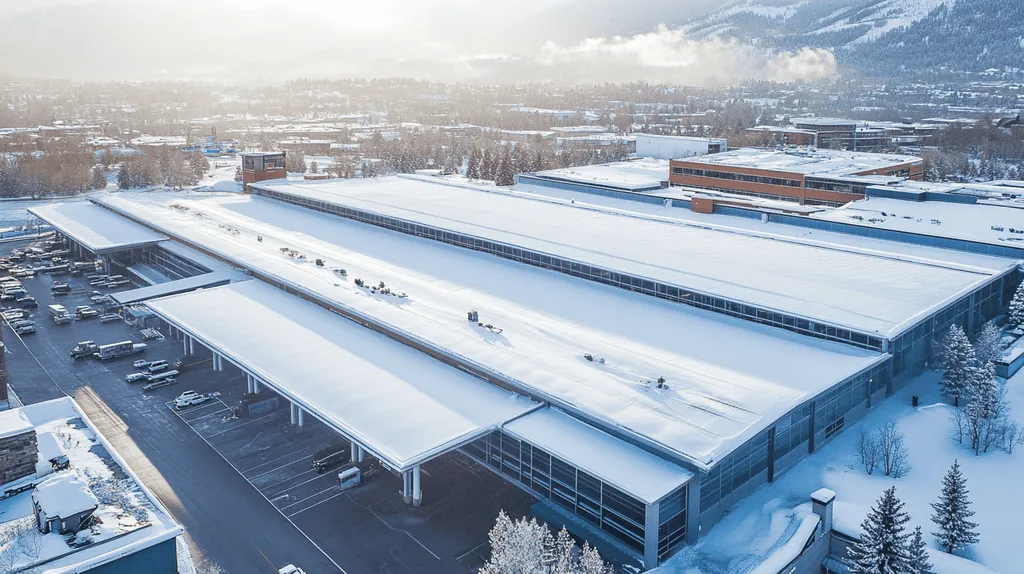Wind damage costs commercial property owners over $3 billion annually in repairs, with up to 40% of roof failures linked to inadequate wind protection measures.
While adding an overhang appears to be a straightforward solution for protecting commercial roofs, this widespread assumption overlooks crucial engineering principles and can lead to costly mistakes.
This comprehensive analysis examines the technical realities of roof overhangs, separating proven practices from dangerous misconceptions that put buildings at risk.
Understanding these distinctions enables property managers to make informed decisions about wind protection strategies while avoiding common pitfalls that compromise roof integrity.
SECTION 1: COMMON MISCONCEPTIONS
Wind damage remains a significant threat to commercial roofs, leading to expensive repairs and potential safety issues. Many property owners mistakenly believe that adding an overhang is an easy fix for this intricate problem. However, treating overhangs as a one-size-fits-all solution can result in poor decisions and unforeseen challenges. This section clarifies three persistent misconceptions about overhangs and their effectiveness in combating wind damage in commercial roofing.
Overhangs as a Panacea for Wind Damage
Various property owners see overhangs as a straightforward remedy for wind-related roofing problems. While they can provide some protection, overhangs are far from a universal solution. Without a solid understanding of wind dynamics, relying solely on them can lead to a false sense of security.
In wind-prone areas, simply adding an overhang might increase the roof’s overall load. This additional stress can lead to structural failures if the roof was not designed to accommodate it. Consulting with roofing professionals is essential to identify optimal strategies tailored to specific conditions.
Furthermore, overhangs can create wind vortices that exacerbate stress on the roof surface. This highlights the need for a comprehensive approach rather than a quick-fix mindset.
Ultimately, using overhangs as a standalone solution can overlook crucial elements of roof engineering that contribute to overall resilience.
Misunderstanding Roof Design and Wind Resistance
It is a common misconception that adding an overhang automatically enhances a roof’s wind resistance. However, wind resistance is influenced by numerous factors, including roof material, slope, and overall design. Each of these aspects plays a critical role in how a roof interacts with wind forces.
For example, a low-slope roof may not benefit from an overhang as much as a steep-sloped roof would. Misjudging these design intricacies can lead property owners to invest in unnecessary modifications that yield minimal benefits.
Additionally, different roof types have distinct responses to wind pressures. Research indicates that flat roofs are more vulnerable to wind uplift compared to sloped roofs, emphasizing the need for tailored solutions. Adding overhangs without thoroughly assessing these design factors can compromise a building’s integrity.
This misunderstanding can drive up maintenance costs and create safety risks. Engaging qualified roofing experts is crucial for property owners to grasp the specific interactions between design features and wind dynamics.
Ignoring Local Climate and Building Codes
Every region has unique wind patterns and climate conditions that significantly influence roofing performance. Overlooking these local factors when considering an overhang can result in serious mistakes. Building codes also dictate what is permissible for specific areas.
For instance, hurricane-prone regions have strict regulations to maximize structural integrity against high winds. An overhang that looks good based on local aesthetic preferences may not comply with safety standards designed for severe weather conditions. This oversight can lead to costly fines and repairs.
Moreover, local climate affects how roofing materials degrade over time. In areas with heavy rainfall, materials can deteriorate faster than in drier regions, impacting an overhang’s long-term viability. Recognizing the local environment is key for effective roofing solutions.
Ignoring these critical factors can undermine the intended advantages of an overhang, leading to dangerously inadequate roofing systems. Consulting local experts ensures that property owners can navigate these important considerations effectively.
SECTION 2: PRACTICAL IMPLICATIONS
Adding an overhang to a commercial roof can profoundly impact various aspects of a building’s performance. For example, roofs without adequate overhangs are especially vulnerable to wind damage, a concern that becomes critical in storm-prone areas. Research indicates that buildings equipped with proper overhangs can decrease wind uplift by as much as 30%. Understanding these practical implications is essential for property owners and facility managers looking to enhance their roofs’ durability, energy efficiency, and maintenance longevity.
Impact on Roof Structural Integrity
The structural integrity of a roof is crucial for any commercial building. Overhangs play a significant role in distributing wind loads evenly across the roof surface. This effective load distribution minimizes stress concentrations, thereby reducing the chances of roof failure during intense weather events.
For example, commercial buildings in high-wind regions that incorporate overhangs often show fewer instances of roof damage than those without them. Additionally, overhangs can provide effective protection against water intrusion by directing rainwater away from the roof edges.
Recognizing these structural benefits is vital for facility managers assessing roof design. Properly installed overhangs can lead to roofs that last longer, ultimately translating to cost savings on repairs and replacements.
Incorporating overhangs into a roof design can enhance durability and extend operational lifespan, ensuring reliable building performance amid challenging environmental conditions.
Effects on Building Energy Efficiency
Energy efficiency has become increasingly critical in the realm of commercial real estate. Overhangs contribute significantly to managing thermal loads by providing essential shade, which reduces heat gain through roof surfaces. This shading can lead to lower cooling costs, particularly in warmer climates.
Research suggests that buildings with adequately designed overhangs may experience a reduction in energy consumption of up to 15%. By reflecting sunlight and minimizing direct exposure, overhangs help maintain a stable indoor temperature.
This energy efficiency has direct implications for operational costs incurred by facility managers. With decreased reliance on air conditioning systems, businesses can allocate resources more effectively, enhancing overall financial performance.
Ultimately, overhangs not only support sustainability initiatives but also contribute to the comfort of occupants, making them a wise investment for any commercial property.
Influence on Maintenance and Repair Costs
Maintaining and repairing commercial roofing systems can incur substantial expenses. However, installing overhangs can significantly mitigate these costs. By protecting roof edges from direct exposure to rain and sun, overhangs reduce the risk of premature material deterioration.
Moreover, the shade provided by overhangs minimizes thermal cycling, a primary cause of fatigue in roofing materials. This reduction in wear translates to fewer repairs and less frequent replacements, ultimately resulting in long-term savings.
Facility managers should take these financial implications seriously. Adding overhangs to roof designs can mean fewer service calls and a more predictable maintenance budget.
Thus, the strategic inclusion of overhangs can lead to substantial financial relief by extending roof lifespan and fostering a more sustainable approach to building maintenance.
SECTION 3: COST OF MISINFORMATION
The dangers of misinformation in roofing design can have serious financial repercussions. A roof lacking adequate overhangs is particularly susceptible to wind damage, leading to potential repair costs that can escalate quickly. Industry data reveals that around 30% of roofing failures are attributable to design or installation errors, emphasizing the importance of informed decision-making. For property owners and facility managers, understanding these financial risks is crucial in safeguarding their investments.
Financial Consequences of Inadequate Design
When overhangs are inadequately designed, the financial implications can be severe. Ignoring wind load considerations might not only cause roof failure but could also result in repair costs soaring into the tens of thousands. In contrast, the initial expense of a well-thought-out design is minor when compared to the potential financial fallout from inadequate protection.
A study suggests that investing one dollar in preventive design can save property owners up to five dollars in repairs over time. Neglecting to install properly sized overhangs can jeopardize long-term financial health, leading to extended repairs and interruptions that further strain budgets.
High-quality roof design, customized to local environmental conditions, is essential for longevity and property value. Failing to prioritize these factors can diminish future resale opportunities, as a structurally sound roof enhances a building’s appeal and worth.
Hidden Costs of Poor Installation Practices
The installation process poses significant risks, particularly when misinformation leads to substandard practices. An overhang that is improperly installed may fail to provide adequate wind resistance. This can result in unexpected repair costs from water damage and structural issues.
Using unqualified labor or disregarding proper training can lead to a range of problems. Overhangs that are not correctly secured can detach under stress, exposing owners to liabilities and costly repairs. Although these hidden expenses are challenging to quantify, they can escalate into significant financial burdens over time.
Additionally, poor installation practices can invalidate manufacturer warranties. This leaves property owners financially vulnerable if problems arise after installation. Adhering to manufacturer guidelines and ensuring comprehensive training are essential to mitigate these risks.
Long-Term Expenses of Neglected Maintenance
Ignoring effective maintenance practices can result in cumulative costs that property owners often underestimate. Without proper inspections, overhangs may promote moisture retention, leading to faster deterioration and premature roof replacements.
Regular maintenance checks are vital for identifying and addressing minor issues before they develop into major problems. The cost savings associated with preventive maintenance are typically far less than the expenses related to emergency repairs. Overlooking maintenance can also result in uncomfortable working conditions, impacting overall productivity.
By investing in a robust maintenance plan, property owners can extend their roof’s lifespan and potentially realize significant savings. Addressing these long-term expenses proactively allows for improved operational efficiency and peace of mind.
SECTION 4: REALITY CHECK
Understanding the impact of wind on commercial roofs is crucial for effective protection and longevity. Wind damage is a leading cause of roofing failures, contributing to over 50% of roof-related insurance claims. To make informed decisions about roofing structures, it is essential to grasp the significance of wind load calculations, material choices, and routine inspections. This section delves into these key factors, ensuring facility managers can protect their investments effectively.
Understanding Wind Load Calculations
Wind load calculations are vital for designing roofs sturdy enough to handle nature’s forces. These calculations determine the wind pressure a roof can withstand, directly influencing its structural capacity. Ignoring local wind speeds can result in weak designs, increasing vulnerability to damage.
For instance, buildings in hurricane-prone regions demand stronger roofing systems than those in calmer areas. The difference can directly impact a roof’s performance in severe weather. Understanding local wind patterns is not merely good practice; it’s essential for protecting property and occupants.
Moreover, it is essential to keep wind load calculations up to date, reflecting new regulations and findings. Changes in industry standards based on recent research or catastrophic events must be integrated into roof designs. Maintaining compliance with updated regulations fosters safety and enhances a roof’s long-term resilience.
In summary, rigorous wind load calculations aren’t just beneficial—they are essential for maintaining robust roofing systems and avoiding costly repairs.
Role of Roofing Materials in Wind Resistance
The choice of roofing materials significantly impacts a roof’s ability to resist wind damage. Not all materials provide equivalent protection against high winds. For example, metal roofing is often preferred for its lightweight and durable characteristics, which enhance wind resistance.
In contrast, traditional asphalt shingles may not hold up under extreme wind conditions, leading to significant roof loss. Studies confirm that roofs made with wind-resistant materials are less likely to fail during gusty weather.
Installation techniques also play a critical role in the performance of roofing materials. Even top-quality materials can underperform if not installed correctly. Adhering to manufacturer guidelines and employing skilled labor can maximize the protective capabilities of roofing installations.
In conclusion, carefully selecting the right roofing materials is crucial for creating roofs engineered for wind resistance and durability, thereby safeguarding valuable assets beneath.
Importance of Regular Inspections
Regular inspections are essential for identifying weaknesses that could lead to wind damage. Over time, roofs can develop vulnerabilities, especially in areas where materials may have degraded or been improperly installed. Routine inspections catch these issues early, preventing more significant problems.
For instance, areas like flashing around vents and chimneys can become loose, allowing water to enter during wind-driven rain. By addressing these issues promptly, property managers can avert extensive damage.
Inspection schedules should consider local weather patterns and the frequency of strong winds. For properties in high-risk areas, bi-annual inspections help ensure that any wear or damage is promptly addressed.
Ultimately, proactive inspections not only preserve roof integrity but also extend the lifespan of roofing systems. Integrating regular inspections into overall maintenance routines is a fundamental aspect of effective roof management.
SECTION 5: EVIDENCE-BASED ALTERNATIVES
The integrity of a commercial roof is critical, especially in wind-prone regions where millions are lost each year to wind-related damage. With such significant stakes, it’s essential to explore evidence-based alternatives rather than solely relying on overhangs. This section highlights impactful strategies, including selecting wind-resistant roofing materials, implementing professional maintenance strategies, and utilizing intelligent rooftop monitoring systems.
Selecting Wind-Resistant Roofing Materials
Choosing the right roofing material can dramatically enhance a roof’s resilience against wind damage. Options such as modified bitumen and standing seam metal roofing provide superior durability, specifically designed to resist uplift forces. For instance, metal roofs can withstand wind speeds of up to 140 mph, making them particularly suitable for areas susceptible to hurricanes.
Modern materials are increasingly incorporating advanced technologies, offering greater flexibility and stronger fastening systems. These innovations create a formidable barrier against wind forces, helping property owners minimize future repair costs and protect their investments.
Furthermore, it is vital for properties in high-wind zones to comply with local building codes that outline wind load requirements. Adhering to these regulations not only ensures safety but also aligns with industry standards for maintaining overall roof integrity.
Ultimately, selecting wind-resistant roofing materials is key to establishing a solid defense against wind damage. Smart choices in materials pave the way for durable roof performance.
Implementing Professional Maintenance Strategies
Routine professional maintenance is essential for spotting vulnerabilities in a roofing system before they escalate into significant issues. Regular inspections can reveal weak points such as loose seams or blocked drainage systems that may worsen during wind events. Property managers should schedule inspections at a minimum of twice a year, preferably before and after the storm season.
Qualified roofing professionals can identify necessary repairs and suggest preventive measures during these inspections. For example, reinforcing seals around roof penetrations can help maintain integrity when high winds strike. Taking such proactive steps not only extends the lifespan of the roof but also bolsters its wind resistance.
Maintaining clear drainage pathways is another critical aspect; it mitigates the risk of water accumulation that can heighten pressure on the roofing system during storms. By prioritizing maintenance, property owners can significantly decrease the likelihood of wind-related damage.
Documenting inspections and repairs is also integral to a comprehensive maintenance strategy. This documentation is a valuable resource for warranty claims and future planning, facilitating effective management of roofing investments.
Utilizing Intelligent Rooftop Monitoring Systems
The introduction of intelligent rooftop monitoring systems can transform how property owners manage roofing. These advanced systems provide real-time insights into varying roof conditions, including temperature changes, moisture levels, and overall structural integrity. With this information, facility managers can quickly address potential issues.
Smart sensors can detect unusual structural movements that may indicate wind-induced stress, allowing property owners to respond before damage escalates. This proactive approach helps mitigate repair costs while enhancing overall rooftop resilience.
Additionally, data from these monitoring systems can inform decisions on future roofing projects or renovations. Understanding a roof’s response to environmental factors helps guide material choices and design adjustments.
Investing in smart rooftop monitoring not only boosts proactive problem-solving but also builds a culture of maintenance awareness. A well-informed team, utilizing accurate data, ensures that roofing systems remain strong in the face of wind and other environmental challenges.
SECTION 6: TEST AND VERIFY
Ensuring a commercial roof remains structurally sound is crucial, especially in areas vulnerable to high winds. Studies indicate that nearly 50% of roofing failures can be attributed to insufficient maintenance and inspection practices. Regular evaluations not only extend a roof’s lifespan but also significantly reduce the risk of costly repairs following severe weather events. This section emphasizes the critical nature of ongoing inspections, post-storm assessments, and the importance of meticulous documentation.
Conducting Regular Roof Inspections
Regular inspections are essential for pinpointing potential roofing problems before they worsen. It is advisable for property owners to arrange bi-annual inspections, preferably before and after the storm season. These evaluations enable roofing professionals to identify early signs of deterioration, such as loose seams or compromised flashing, which could threaten the roof’s integrity.
The objective of these inspections is to gather comprehensive data regarding the roof’s health. Utilizing advanced technologies like infrared scans or drones can enhance the detection of hidden problems, such as moisture intrusion or insulation issues that are not easily visible.
Qualified professionals can deliver a detailed report that outlines the roof’s current condition. This report should specify necessary repairs and recommended preventative measures. Dedicating time and resources to thorough inspections can drastically lower the risk of wind-related damage during storms.
Finally, establishing a routine for inspections fosters a proactive maintenance culture, prompting swift action on minor issues before they escalate into major, costly failures.
Assessing Damage After Wind Events
Following a wind event, prompt damage assessment is critical. High winds may cause hidden damage that doesn’t manifest immediately. Property owners should enlist roofing experts to conduct a thorough inspection as soon as possible to preempt long-term issues.
Key focus areas should include missing shingles, broken tiles, and compromised seams. Such damages can lead to leaks or structural failures if not addressed immediately. A clear understanding of the extent of damage supports informed decisions regarding repairs or potential roof replacement.
Moreover, documenting the assessment is essential for insurance claims. An accurate report illustrating the damage from the wind will bolster claims for repairs, potentially saving considerable costs for property owners.
Additionally, evaluating the roof’s performance during wind events can yield insights on whether the current design suffices. If damage recurs, it may suggest that modifications, like installing an overhang, are essential for enhanced future protection.
Documenting and Reviewing Maintenance Records
Comprehensive documentation of all maintenance activities is crucial for the longevity of a commercial roof. Maintaining precise records allows property owners to track the roof’s condition over time, revealing patterns that indicate when extra interventions might be necessary.
Annual reviews of maintenance logs are essential. This examination can highlight recurring issues or overlooked inspections that may jeopardize the roof’s effectiveness. Consistent analysis of these records ensures that critical attention is given to any significant concerns.
Another important aspect of documentation is compliance with warranty requirements. Many roof warranties stipulate regular maintenance to maintain their validity. Keeping maintenance records current safeguards both the investment and warranty coverage.
In summary, recording and reviewing maintenance activities is a strategic method for managing roofing assets. This practice promotes accountability while enabling informed choices regarding necessary future upgrades or replacements.
The Bottom Line
Wind damage to commercial roofs results in over $3 billion in annual losses, with improper overhang design contributing significantly to these costs.
While overhangs can enhance wind resistance when properly engineered, their effectiveness depends on multiple factors including local climate conditions, building codes, and structural considerations.
Property owners must recognize that overhangs represent just one component of a comprehensive wind protection strategy that should include wind-resistant materials, professional maintenance protocols, and regular inspections.
Moving forward, facility managers should prioritize evidence-based solutions, leveraging advanced monitoring systems and documented maintenance practices to protect their roofing investments.
Success in mitigating wind damage requires an integrated approach that combines proper design, quality materials, and ongoing vigilance through professional inspections and maintenance.
FREQUENTLY ASKED QUESTIONS
Q. Can overhangs completely protect a commercial roof from wind damage?
A. Overhangs can provide some protection, but they are not a standalone solution. They should be part of a comprehensive approach to roof design that considers wind dynamics and overall structural integrity. Relying solely on overhangs may lead to inadequate protection and increased risk of damage during severe weather.
Q. How do overhangs impact the energy efficiency of commercial roofs?
A. Properly designed overhangs can significantly enhance a roof’s energy efficiency. They provide shade that reduces heat gain, thereby lowering cooling costs in warmer climates. Research indicates that buildings with suitable overhangs may see a reduction in energy consumption, ultimately benefiting operational budgeting.
Q. What are the financial risks of inadequate roof design for commercial roofs?
A. Inadequate roof design can lead to severe financial implications, including high repair costs from wind damage. Without proper overhangs, a roof is more susceptible to wind uplift, increasing vulnerability to failure. Investing in quality design is far more cost-effective than handling extensive repairs caused by inadequate protection.
Q. Why are regular inspections vital for maintaining a commercial roof?
A. Regular inspections are essential for identifying vulnerabilities before they escalate into costly repairs. They assist in detecting early signs of damage or wear, ensuring timely interventions that prolong the roof’s lifespan. Proactive inspections mitigate risks associated with wind damage during extreme weather events.
Q. How can selecting the right materials enhance a commercial roof’s wind resistance?
A. The choice of roofing materials significantly impacts wind resistance. Materials like metal roofing provide enhanced durability against high winds compared to others like asphalt shingles. Selecting appropriate materials as per local wind load requirements establishes a strong defense against wind damage and enhances the overall resilience of the roof.
Q. What are cost-effective alternatives to just adding overhangs to a commercial roof?
A. Evidence-based alternatives include selecting wind-resistant roofing materials and implementing a professional maintenance strategy. Conducting regular inspections can also help identify issues early, reducing the likelihood of expensive repairs. These strategies build a robust roofing system more effectively than relying solely on overhangs for protection.
Q. What is the significance of documentation in roof maintenance?
A. Documentation is crucial for maintaining a commercial roof’s effectiveness and warranty compliance. Keeping accurate records of inspections, repairs, and maintenance activities allows property owners to track roof health over time, which helps in timely interventions and informs decisions on future upgrades or replacements.

